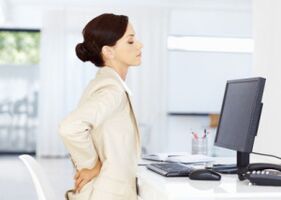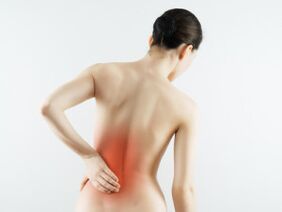Decades ago, osteochondrosis was an age-related disease. He's younger now. It is worth knowing the symptoms, the treatment of lumbar osteochondrosis, in order to understand the importance of paying attention to health.
Inflammation of the lumbosacral region is often diagnosed. It causes severe pain, deprives the person of mobility. There are no recovery methods, it is recommended to stop the progression at an early stage.
Causes of lumbar osteochondrosis
It is worth determining the cause of the event. If left untreated, treatment temporarily relieves symptoms.

Causes of lumbar osteochondrosis:
- Overweight. Being overweight increases the load on the spine and the center of gravity shifts. Lumbar discs wear out, wear out - osteochondrosis.
- Disruption of metabolic processes. There are no blood vessels in the cartilage tissue of the spine and you cannot get life-giving substances from the inside. It receives nutrients in exchange for adjacent tissues, disrupting the process leading to gradual death.
- Improper walking, movement, weight lifting. Lumbar osteochondrosis is often diagnosed in people who carry weights and are overweight. The inability to control the body and movements negatively affects the spine.
- Back injury, infection. Osteochondrosis of the lumbar bone is a disease of athletes. Increased stress and injuries often lead to deterioration of the condition of the intervertebral discs. They often sacrifice health for prizes and records.
- Heredity. In some cases, the structure of the intervertebral discs is initially more porous and looser. Joints require proper nutrition and respect.
- Passive lifestyle. Related reason. A sedentary lifestyle leads to a deterioration of metabolic processes. In a sitting position, the spine is the most stressful.
Symptoms of the disease
It is worth knowing the symptoms of lumbar osteochondrosis to diagnose the disease. The main one is back pain. It is present during the exacerbation of the disease, during a period of unnoticed course. It is recommended to pay attention to low back pain at the beginning of the disease. Doctors diagnose the disease based on five symptoms:
- Closed. Severe pain in the lower back when trying to straighten. The pain is accompanied by increased stress on the back muscles. In a supine position, the pain goes away.
- Back pain. Sharp feelings of pain in people who lead a sedentary lifestyle after physical exertion. They appear during movements, unpleasant turns, loads. Tensile back pain can be observed continuously.
- Numbness. It is observed in different zones, depending on the disease-causing intervertebral disc. Localization is determined by numbness zones. It covers the buttocks, thighs, legs, feet.
- Cool. The decrease in skin temperature is caused by the compression of arteries and blood vessels, and the decrease in metabolic processes.
- Violation of genitourinary functions. A common symptom of lumbar osteochondrosis that is not treated is a "neglected" condition. There is a frequent urge to go to the toilet, on the contrary, there are problems with that.
- Decreased activity. In order not to injure your back, do not cause pain, a person tries to move carefully, less. Over time, this will lead you to stop walking, take care of yourself.
It is important to treat lumbar osteochondrosis, to determine the location of the process and the degree of development. Diagnosis is made by X-ray, magnetic resonance imaging.
Treatment method

The spine cannot be restored. The treatment lasts a lifetime. The disease progresses with the wrong approach, which leads to unpleasant consequences.
It is based on the principle of treatment. Your doctor will prescribe medications, procedures that will eliminate the symptoms. After changing treatments, when the disease temporarily does not manifest itself, it worsens again. Follow the plan:
- Eliminating the causes of the disease. Lifestyle changes, exercise, fighting overweight, eliminating metabolic disorders, foci of infection.
- Suppression of concomitant diseases. Osteochondrosis causes disease. It causes hypertension, radical syndrome, and leads to diseases of the urinary system.
- Stimulation of regeneration of damaged areas. Use medications to treat anti-inflammatory, restorative-type lumbar osteochondrosis.
- Removal of inflammation. The cause of the pain is the development of inflammation. It is worth achieving muscle relaxation, improving blood circulation, relieving pain, blocking inflammatory enzymes.
- Changing habits. The patient should develop habits that facilitate the course of the disease and promote recovery. Useful habits - therapeutic exercises, dieting.
As the disease worsens, the doctor is responsible for relieving the symptoms. You often have to deal with severe pain. Once the cause is diagnosed, the patient prescribes an analgesic, NSAID. The substances block the nervous system, suppress the foci of pain, relieve swelling.
Before the doctor arrives, it is recommended to use special ointments, topical gels, and tablets to relieve the pain syndrome, for temporary relief. It is recommended to lie down, put warmth on the sore spot to improve blood circulation, relieve the lower load on the back.
In remission, treatment of acute osteochondrosis of the lumbar spine involves taking chondroprotectors involved in the repair of damaged tissues. Procedures are prescribed: massage, acupuncture. There are many different techniques. Relieve muscle tension, stretch your spine. Exercise and training therapy are part of the treatment process. If you follow your doctor's instructions, the likelihood of relapse will decrease.
Sometimes the treatment is performed surgically. The patient removes the hernias, relieves vasoconstriction, and places special prostheses.
Self-healing, advice from friends is the worst treatment option. Only a doctor can prescribe special medications and give advice. Traditional methods are used before a doctor’s visit, who try not to postpone it. The most important thing is not to hurt.
Complications of lumbar osteochondrosis
If the methods of treating lumbar osteochondrosis are not followed, complications develop. The lumbar region is characterized by mobility. The longitudinal nerves are responsible for the lower extremities, the pelvic organs.
The development of the disease leads to a reduction in the space between the vertebrae. Blood vessels and nerve bundles pass through the holes. Squeezing them leads to severe pain while moving. If you have a spinal cord sting, it will affect the whole body.
Unpleasant consequences - numbness, paralysis of the lower limbs, buttocks. The work of the pelvic organs is interrupted. Lameness occurs.
The groin is an important part of the spine and should be handled with care. Osteochondrosis is a common disease.

















































